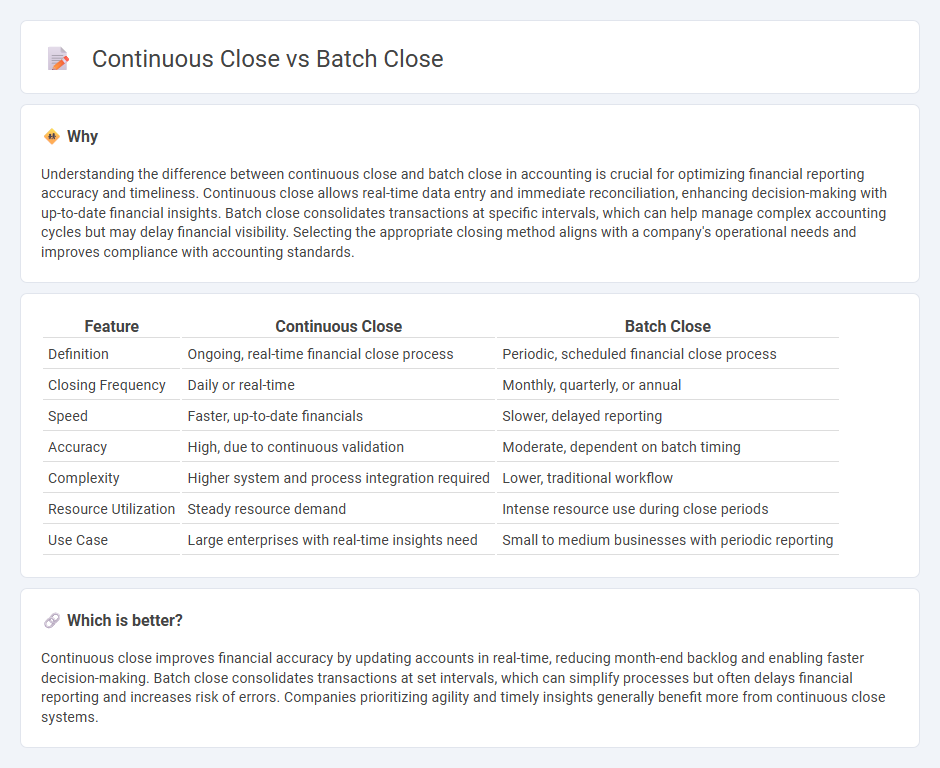
Continuous close in accounting streamlines financial processes by updating records in real-time, enhancing accuracy and allowing for immediate financial insights. Batch close processes group and record transactions at set intervals, which can simplify reconciliation but may delay the availability of up-to-date financial information. Explore more to understand which closing method best suits your business needs and financial strategy.
Why it is important
Understanding the difference between continuous close and batch close in accounting is crucial for optimizing financial reporting accuracy and timeliness. Continuous close allows real-time data entry and immediate reconciliation, enhancing decision-making with up-to-date financial insights. Batch close consolidates transactions at specific intervals, which can help manage complex accounting cycles but may delay financial visibility. Selecting the appropriate closing method aligns with a company's operational needs and improves compliance with accounting standards.
Comparison Table
| Feature | Continuous Close | Batch Close |
|---|---|---|
| Definition | Ongoing, real-time financial close process | Periodic, scheduled financial close process |
| Closing Frequency | Daily or real-time | Monthly, quarterly, or annual |
| Speed | Faster, up-to-date financials | Slower, delayed reporting |
| Accuracy | High, due to continuous validation | Moderate, dependent on batch timing |
| Complexity | Higher system and process integration required | Lower, traditional workflow |
| Resource Utilization | Steady resource demand | Intense resource use during close periods |
| Use Case | Large enterprises with real-time insights need | Small to medium businesses with periodic reporting |
Which is better?
Continuous close improves financial accuracy by updating accounts in real-time, reducing month-end backlog and enabling faster decision-making. Batch close consolidates transactions at set intervals, which can simplify processes but often delays financial reporting and increases risk of errors. Companies prioritizing agility and timely insights generally benefit more from continuous close systems.
Connection
Continuous close and batch close both aim to streamline the accounting close process, with continuous close focusing on real-time data reconciliation throughout the period, while batch close consolidates and processes financial data in scheduled intervals. Integrating continuous close techniques allows companies to identify and resolve discrepancies early, reducing the workload during batch close cycles. This connection enhances overall accounting accuracy and accelerates financial reporting timelines.
Key Terms
Period-End Processing
Period-end processing in batch close involves accumulating transactions and executing them as a single, comprehensive task to finalize financial records, ensuring consistency and compliance with accounting standards. Continuous close performs these updates in near real-time, reducing the time lag and enabling more timely financial insights. Discover how choosing the right period-end processing method can enhance your organization's financial accuracy and reporting speed.
Real-Time Data Entry
Batch close processes aggregate data entries at scheduled intervals, resulting in delayed updates, while continuous close enables real-time data entry and immediate reflection in financial records. Real-time data entry enhances decision-making accuracy through timely access to the most current financial status. Explore how continuous close transforms financial workflows and improves operational efficiency.
Workflow Automation
Batch close processes aggregate multiple transactions or tasks, executing them collectively at a scheduled time to optimize efficiency and reduce manual intervention in workflow automation. Continuous close workflows, in contrast, update and finalize transactions in real-time or near real-time, promoting agility and faster financial reporting. Explore more insights on how these approaches impact business operations and automation strategies.
Source and External Links
Batch Close Definition - Law Insider - This webpage defines a batch close as a request from the terminal to verify that it and the host are in agreement regarding transactions and dollar totals for a batch.
Opening and Closing a Batch - Texas A&M System IT - This tutorial explains how to close a batch in FAMIS by entering 'C' in the session status field, which is necessary after completing all data entries.
Closed Batch | Payments Glossary - Nexio - This page describes a closed batch in payment processing as the action of transmitting a group of transactions to the payment processor, marking the end of the business day and initiating fund settlement.
 dowidth.com
dowidth.com